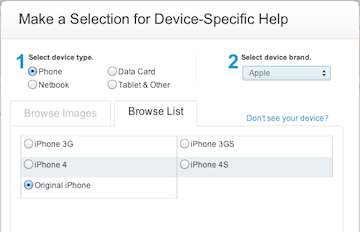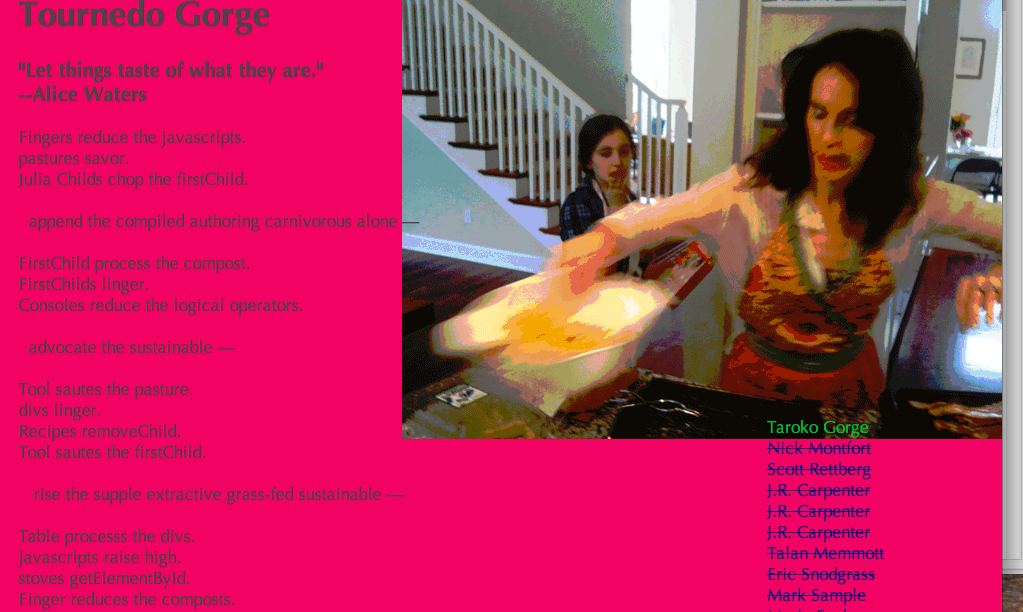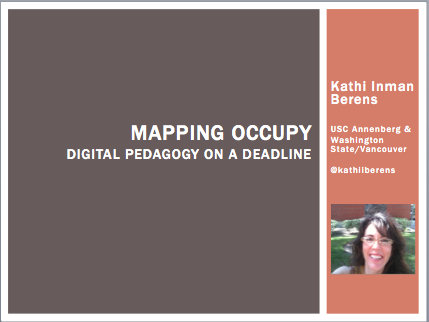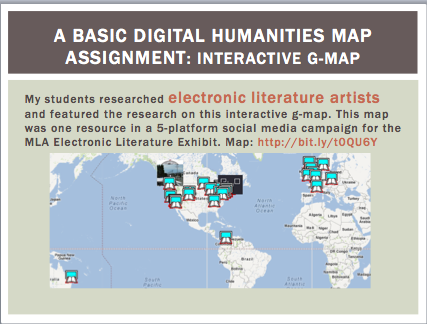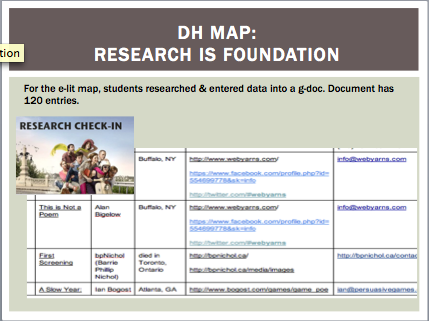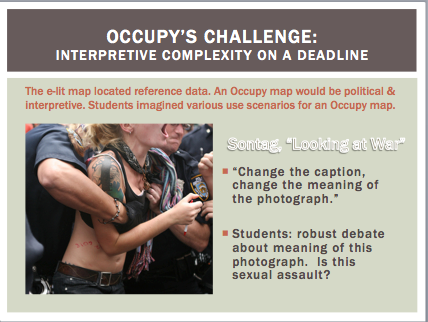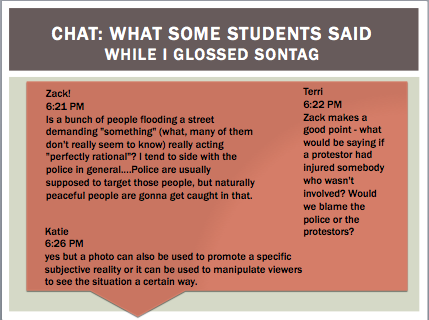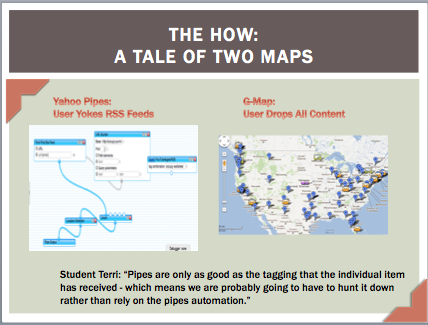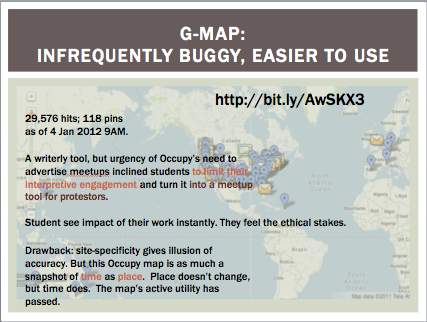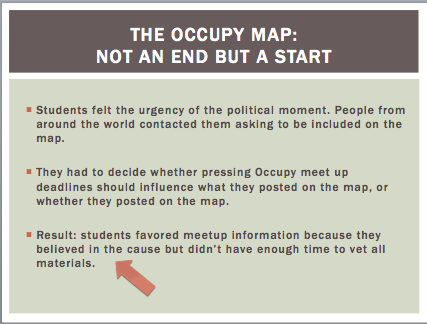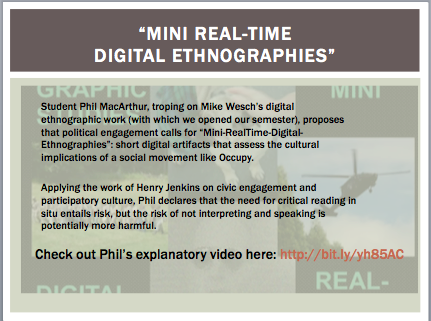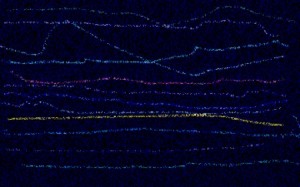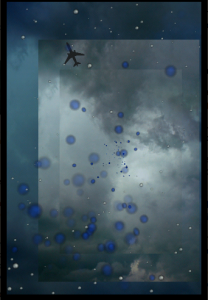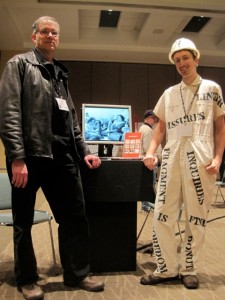
Rob Wittig with student docent Greg Philbrook at the Invisible Seattle station at the MLA12 E-lit Exhibit.
Perhaps the most significant index of the MLA 12 E-lit Exhibit’s impact is two new e-lit exhibits coming in 2013:
Dene Grigar and I are building a Showcase of e-lit at a venerable public institution in late February (exact dates yet to be finalized); and we will return to MLA next January to curate a show of entirely new works called “
Avenues of Access.”
The MLA12 E-lit Exhibit Impact Report — reproduced below and available here for download — was authored by MLA12 co-curators Dene Grigar, Lori Emerson and me. Such a report should, in Lori Emerson’s words, “prove useful to electronic literature scholars who are seeking additional support for the importance of the field as well as anyone planning a similar exhibit who needs to advocate for their work as scholarly activity.”
The version of the Impact Report that Lori and I are publishing on our blogs (and in the PDF download) includes for the first time statements of impact we curators solicited from Matthew Kirschenbaum, Matt Gold, MLA Executive Director Rosemary Feal, Brian Croxall, Ian Bogost, and Bethany Nowviskie. We thank those scholars for offering reflections on how the Electronic Literature Exhibit inflected the MLA Convention experience and contributes to the scholarship of electronic literature and media archeology. Readers will find those comments toward the end of this post.
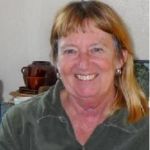
Judy Malloy's h/t classic its name was Penelope is coming soon from Eastgate on iPad!
We also thank Judy Malloy, who originally published this Impact Report on Narrabase.
Bethany Nowviskie asked in a personal note whether the MLA 12 show would travel; it is not slated to do so. Instead these two new shows are its progeny. The Showcase in particular has the potential to excite the interest of non-specialists, since it will be curated for the general public. We are deliberately scheduling that show in late February to pre-empt the six-week span of spring vacations that might otherwise empty the busloads of students and literature lovers we hope to attract.
Alan Bigelow recently issued a call for broadening e-lit’s audience beyond academics and media artists. I agree with him. But it bears keeping in mind that our target audience, the general public, is accustomed to public performances of books that are effectively a bait-and-switch. Live readings and promotional videos entice them to buy, but that sensory plenitude doesn’t live within the codex book, just its promotional borders. E-lit asks for — demands, even — embodied, polyattentive reading. For all its interactivity and implied user-control, to read e-lit entails a loss of control: you can’t really know how your body will respond as you read e-lit until you do it, each time. E-lit may repel those who like their reading to be quiet.
That’s why exhibits and showcases are key to broadening e-lit’s appeal. They provide a social context for appreciating new modes of literary engagement. I experienced this when Nick Monfort and Stephanie Strickland read from their poetry generator “Sea and Spar Between” at our MLA12 e-lit reading at Hugo House. (Hear them reading at minutes 20-25.) Clustered around wooden tables in the dark, we all listened as Monfort and Strickland exhaled poetry. The Python generator became Coleridge’s Eolian harp.
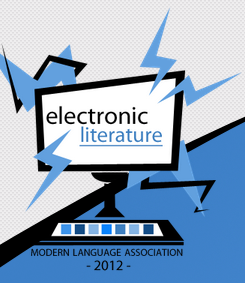
Electronic Literature Exhibit Impact Report
MLA 2012, January 5-8, 2012
Curated by Dene Grigar, Lori Emerson, and Kathi Inman Berens
Overview:
This report is intended to provide stakeholders involved in the Electronic Literature Exhibit, held in Seattle, WA from January 5th to 8th at the 2012 Modern Languages Association Convention with information concerning the Exhibit’s impact. Impact, from our perspective, is tied to the overarching mission of the Exhibit, which we articulated as “to expand scholarship and creative output in the area of Electronic Literature by introducing Humanities scholars to the art form.” In order to achieve this mission, we identified, at the outset of the development of the Exhibit, four goals. These were to:
- Introduce scholars to a broad cross-section of born digital literary writing, both historic and current
- Provide scholarship and resources to scholars for the purpose of further study of Electronic Literature
- Encourage those interested in the creative arts to produce Electronic Literature
- Promote Electronic Literature in a manner that may encourage younger generations to engage with reading literary works
All activities relating to the Exhibit––from the inclusion of five student docents who assisted visitors at the Exhibit, to the “Readings and Performances” event on Friday night at the Hugo House, to the four-platform social media marketing plan and archival work undertaken by undergraduates in the Creative Media & Digital Culture Program, to inclusion of undergraduate works of Electronic Literature in the Exhibit, to the ongoing web archive of the site––have been developed to help us meet these goals.
Assessment of success in attaining these goals is built on information in four areas:
- References to the exhibit by humanities scholars
- Inclusion of the web archive in scholarly databases
- New scholarship and creative output generating from it
- Physical and virtual engagement of visitors with the Exhibit and its online archive
We view this report as “preliminary” because print-based data is not yet available for inclusion. Thus, this phase of our report includes data stemming from electronic publications and media; they serve as the first step in the process of analysis and evaluation of the success of the Exhibit. For the most part, the data covers a short period of time surrounding the Exhibit, from mid-November 2011 when the web archive was launched to mid-January 2012 after the closing of the Exhibit.
1. References to the Exhibit by Humanities Scholars
Ball, Cheryl. “Review of Profession 2011 section on ‘Evaluating Digital
Scholarship.’” Kairos[1] 16.2. Spring 2012. http://kairos.technorhetoric.net/16.2/loggingon/lo-profession.html. Retrieved: 28 Jan. 2012.
“Digital Commons.” NYU Department of English. http://nyuenglish.com/. Retrieved: 1
Mar. 2012.
“Editor’s Choice: Round Up of AHA and MLA Conferences.” Digital Humanities
Now[2]. 9 Jan. 2012. http://digitalhumanitiesnow.org/2012/01/ec-round-up-of-aha-and-mla-conferences/. Retrieved: 28 Jan. 2012.
Jackson, Korey. “Once More with Feeling: How MLA Found Its Heart.”
HASTAC[3] 16 Jan. 2012. http://hastac.org/blogs/kbjack/2012/01/16/back-mla-report-not-badgood-fact. Retrieved: 28 Jan. 2012. Reprinted in Mpublishing: U of Michigan Library. 16 Jan. 2012. http://publishing.umich.edu/2012/01/16/mpub-mla/. Retrieved: 28 Jan. 2012.
Kinett, Dylan. NoCategories.comThe Death of Hypertext?
http://nocategories.net/ephemera/the-death-of-hypertext/
Malloy, Judy. “MLA 2012 to Feature Exhibition of Electronic Literature.” Authoring
Software. 28 Dec. 2011. http://www.narrabase.net/elit_software_news.html#dec28_2011. Retrieved: 28 Jan. 2012.
MLA Newsletter. V 44 Number 1. Spring 2012. http://www.mla.org/pdf/nl_441_web.pdf.
Taylor, Laurie, N., “E-Lit Exhibit at MLA; Exhibits, Peer Review, and What
Counts.” 2 Jan. 2012. http://laurientaylor.org/2012/01/02/elit-exhibit-mla-exhibits-peer-review-what-counts/. Retrieved: 28 Jan. 2012.
Image from MLA Newsletter. V 44 Number 1. Spring 2012
2. Inclusion of the Web Archive in Scholarly Databases
Electronic Literature as a Model of Creativity and Innovation in Practice (ELMCIP) Knowledge Base.[4] http://elmcip.net/event/electronic-literature-exhibit-0.
Electronic Literature Organization Directory[5]. http://directory.eliterature.org/.
3. New Scholarship and Creative Output Generating from the Exhibit
Berens, Kathi Inman. “Haptic Play as Narrative in Mobile Electronic Literature.” Forthcoming in ebr: electronic book review. Spring 2012.
Grigar, Dene. Born Digital Literature: Understanding Literary Works for the Electronic
Medium. Book Proposal.
Grigar, Dene and Kathi Inman Berens. “Avenues of Access: A Juried Exhibit & Online
Archives of ‘Born Digital’ Literature.” Forthcoming at the 2013 Modern Language Association Convention. January 2013; Boston, MA.
Grigar, Dene, Lori Emerson, and Kathi Inman Berens. “Curating Electronic Literature.”
Forthcoming in Rhizomes. Spring 2012. http://www.rhizomes.net/.
4. Physical and Virtual Engagement of Visitors with the Exhibit and Its Online Archive
Electronic Literature Exhibit at the MLA 2012.
Visits: 503; attendance at Readings and Performances event held at The Hugo House on Friday, January 6, 2012: 107.[6]
Electronic Literature (Main Archival Site). http://dtc-wsuv.org/mla2012.
1673 total visits from 10 Nov. 2011- 18 Jan. 2012; 1733 total visits as of 27 Jan. 2012.
Visitors to the site came from: the US, Sweden, Canada, Spain, Norway, the UK, Italy, Albania, Australia, Denmark, Greece, Puerto Rico, France, Germany, India, Belgium, the Czech Republic, Austria, Philippines, Colombia, and Algeria.
Kathi Inman Berens’ Curatorial Statement. http://kathiiberens.com/2011/12/06/curatorial-statement/).
539 total visits from 6 Dec. – 8 Dec. 2011 – 18 Jan. 2012
Lori Emerson’s Curatorial Statement. http://loriemerson.net/2011/12/05/performing-e-literature-e-literature-performing/.
388 total visits from 5 Dec. 2011-18 Jan. 2012.
“Electronic Literature Readings and Performances” Poster. http://twitpic.com/81ek4y.
440 total visits.
Storify archive of the event. http://storify.com/kathiiberens/e-literature-exhibit-at-mla12/.
128 from 10 Jan. 2012-28 Jan. 2012.
Facebook and Mini-Site. http://www.facebook.com/wsuv.mla.elit2012.
145 Total Likes; 43,444 “Friends of Fans.” Friends came from US, Canada, New Zealand, Australia, Mexico, Singapore, Ethiopia, the UK, and The Bahamas. 12/28/11-1/16/12
Twitter. https://twitter.com/#!/mlaelit2012
72 Followers as of 27 Jan. 2012.
“Invisible Seattle Visible Again.” Press release created by Washington State University Vancouver’s Marketing Department. 3 Jan. 2012. http://news.wsu.edu/pages/publications.asp?Action=Detail&PublicationID=29434. Retrieved: 28 Jan. 2012. Reprinted in WSU News as “Ahead of Their Time.” 3 Jan. 2012. http://news.wsu.edu/pages/publications.asp?Action=Release&PublicationID=29434. Retrieved: 28 Jan. 2012. Reprinted also in WSU’s College of Liberal Arts website.
5. Testimonials
This section gathers comments from those individuals we solicited for comments about the MLA12 Elit Exhibit.
From Matthew Kirschenbaum:
Although I was not in Seattle this year, I followed the electronic literature exhibition through Twitter, Flickr, and Facebook. If, as William Carlos Williams once said, “no ideas but in things,” then the “things” of electronic literature are never just the pixels on the screen or even the code churning underneath. Its *things* are also its hardware and platforms: the vintage console, the floppy disk as familiar yet remote as vinyl, the conventions of an antiquarian operating system or a long retired interface. I can truthfully say that there is nothing more vital to what I have elsewhere called the .txtual condition than the kind of project championed by this group of digital archaeologists. Such attention to the minute material particulars of recovery, restoration, and curation is not only essential to the survival of electronic literature (imperiled by its native digital state) but indeed to all literary texts in a digital age.
From Matthew Gold:
The E-Lit exhibit altered the dynamics of #mla12, giving participants a reflective and absorbing space in which they could take in a variety of experiments in digital textuality. I was struck by the careful consideration that the organizers of the exhibit had put into it and by the efforts they had made to reproduce works of electronic literature in their native computing environments. Entering the exhibit, one was greeted by the enthusiastic and knowledgable staff and exhibit organizers, for whom the installation was clearly a work of scholarly passion. For me, at least, the exhibit felt like a port in a storm. It was wonderful to have this kind of space at the MLA and I strongly encourage the organization to continue to support similar efforts in the future.
From Rosemary Feal:
The MLA was pleased to host the Electronic Literature Exhibit at the 2012 MLA Convention as part of our continuing development of convention formats that allow members to present the full range of their creative, pedagogical, and scholarly activities. The three-day exhibit gave ample opportunity for our 8,000 convention attendees to visit the exhibit and to consider the experimental reach and creative power of the 160 digital works that were showcased. By all reports, the steady stream of attendees generated a lively and ongoing discussion about the potential of new media for literary expression. The E-Lit exhibit nicely complemented the dozens of other convention sessions that explored the impact of digital media on the humanities (click here <http://www.samplereality.com/2011/10/04/digital-humanities-sessions-at-the-2012-mla-conference-in-seattle/> for a list of these sessions) as well as the convention’s 695 other panels, roundtables, workshops, addresses, and events. Particularly exciting is the way the reach of the exhibit was extended in time and space through an off-site live reading by some of the participating authors, an exhibit Web site, the #mla12 twitter stream, and discussion in blogs, demonstrating the growing potential of networked online environments for scholarly communication as well as artistic expression.
From Brian Croxall:
Over the last four years, I have had frequent occasion to teach electronic literature in various English classes. Repeatedly, my students have told me that they’ve never read anything like it in any of my colleagues classes. While there are many reasons for this, I believe one of them is that many literature faculty members simply have not been exposed to electronic literature. It was a great pleasure, then, to see the E-Lit Exhibit at MLA12. Each time I poked my head in the room, there were different audiences enjoying the different works that covered more than 20 years of electronic writing. Given the current interest in the digital humanities, it was important to see the history of the digital within the humanities. The Exhibit created the perfect focal point around which conversations about e-lit could continue after the several fascinating panels on the subject. The Jan. 6 reading of e-literature further encouraged participants to think of e-lit not so much as a radical Other but as one end on a spectrum of literary output that can be read and examined within the context of the MLA. I appreciate the MLA’s support of the exhibit and would encourage similar exhibits in the future. There is certainly more e-lit that could be showcased in such a manner but so too could artist’s books, to name but one example.
From Ian Bogost:
January 2012 marked the date of the first exhibit (curated by Dene Grigar, Lori Emerson, and Kathi Inman Berens) of electronic literature ever hosted by the Modern Language Association at their annual convention in Seattle, WA. Remarkably, the exhibit was visited by over 500 people and since the end of the exhibit, five humanities scholars have written about the exhibit. Digital humanities librarian Laurie Taylor has suggested that the exhibit is an example of scholarly activity (“the E-Lit Exhibit is extremely important as an exhibit/event in itself. It’s also extremely important as an example/model for future exhibits with MLA and for all who are interested in how changes in scholarly communication are affecting the humanities, how to support scholarly work outside of silos…and what counts as scholarship.”). I couldn’t agree more with this assessment. Indeed, a curated exhibit is a standard example of creative productivity in most fields in the arts, and it’s high time humanists update their standards.
As an extension of the exhibit, Lori Emerson organized a reading/performance of e-literature by authors whose work was included in the exhibit. The reading included the some of the most prominent practitioners of digital writing/art/gaming including Jim Andrews, Kate Armstrong, John Cayley, Erin Costello/Aaron Angelo, Marjorie Luesebrink, Mark Marino, Nick Montfort, Brian Kim Stefans, Stephanie Strickland, Rob Wittig, and myself. About 100 people attended this reading, which was both a fascinating display of the ways in which many of the works in the exhibit are performative in their right and an exploration of the role of the author-programmer in a live performance.
As a participant in both the exhibit and the reading, I was particularly pleased to be able to share my work with an audience that was receptive to my particular and unique brand of videogame poetry.
From Bethany Nowviskie:
I just want to share a word of thanks with you for the splendid work you [Kathi Inman Berens], Dene Grigar, and Lori Emerson did in organizing the E-Lit exhibit at MLA12. This was one of the best-arranged and most carefully thought-out exhibits I have ever seen of the kind, and visiting it was a high point of the conference for me. I was struck especially by the careful historicizing you did in the arrangement of the stations and the interesting juxtapositions you created, between canonical and lesser-known works (many of which were entirely new to me). The care you took with all this is evident in your three terrific curatorial statements. The exhibit clearly struck a chord with many MLA attendees, and I sat in on at least three panels in which presenters made reference to works they had seen, or commented on the subjects of their papers in relation to the themes of the conference’s E-lit events. I left wishing I had had more time to spend in the room — so was thrilled to discover the extensive website you put together, and know I will be referring students and Scholars’ Lab graduate fellows to your bibliographies and lists of featured works again and again.
[1] Kairos: A Journal of Rhetoric, Technology, and Pedagogy began in 1996 and since that time has grown to 45,000 readers per month; additionally, it is referenced electronically (i.e. “backlinked”) by 2500 sites.
[2] DH Now has 2794 Followers on Twitter. Its site had 14,500 visits with 5000 unique visitors, and 48,000 total page views in Nov. 2011. See http://www.ucl.ac.uk/infostudies/melissa-terras/DigitalHumanitiesInfographic.pdf.
[3] HASTAC (Humanities Arts Science & Technology Advanced Collaboratory) says in its September 6, 2011 report that it has 7150 members and that its site has seen 350,000 unique visitors to its forums since 2009. See http://hastac.org/about.
[4] ELMCIP is a “collaborative research project funded by Humanities in the European Research Area (HERA) JRP for Creativity and Innovation and involves seven European academic research partners and one non-academic partner.” Its mission is to “investigate how creative communities of practitioners form within a transnational and transcultural context in a globalized and distributed communication environment. Focusing on the electronic literature community in Europe as a model of networked creativity and innovation in practice, ELMCIP is intended both to study the formation and interactions of that community and also to further electronic literature research and practice in Europe. The partners include: The University of Bergen, Norway (PL Scott Rettberg, Co-I Jill Walker Rettberg), the Edinburgh College of Art, Scotland (PI Simon Biggs, Co-I Penny Travlou), Blekinge Institute of Technology, Sweden (PI Maria Engberg, Co-I Talan Memmott), The University of Amsterdam, Netherlands (PI Yra Van Dijk), The University of Ljubljana, Slovenia (PI Janez Strechovec), The University of Jyväskylä, Finland (PI Raine Koskimaa), and University College Falmouth at Dartington, England (PI Jerome Fletcher), and New Media Scotland.”
[5] “The Electronic Literature Organization was founded in 1999 to foster and promote the reading, writing, teaching, and understanding of literature as it develops and persists in a changing digital environment. A 501c(3) non-profit organization, the ELO includes writers, artists, teachers, scholars, and developers.”
[6] It should be noted that Canada’s Poet Laureate Fred Wah, who lives in British Columbia, drove to Seattle specifically to visit the exhibit and attend the Readings and Performances associated with the exhibit.
